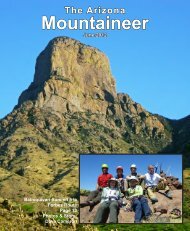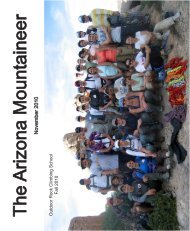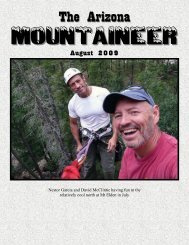Mountaineer - Arizona Mountaineering Club
Mountaineer - Arizona Mountaineering Club
Mountaineer - Arizona Mountaineering Club
Create successful ePaper yourself
Turn your PDF publications into a flip-book with our unique Google optimized e-Paper software.
Glacier Travel, Snow Skills, & Crevasse Rescue Seminar - (Cont)<br />
2. Altitude sickness awareness, AMS, symptoms, CE and PE signs and symptoms, AMS -> Stay put, CE or<br />
PE ->go down<br />
3. Risk management and time management<br />
4. Snow travel on snowshoes and crampons<br />
5. Roped team travel<br />
6. Ice Axe self arrest<br />
7. Snow anchors (Pickets, Flukes, Dead-men, Snow Bollards, nature of snow as an anchoring medium,<br />
matching your anchor to job it needs to perform<br />
8. Methods of dynamic belay, quick belay and running belay<br />
9. Glacier travel: anatomy of the glacier, characteristics of crevasses and snow bridges<br />
10. Crevasse extraction, building the C+Z haul system and the standard three member team rescue scenario,<br />
hauling weight and stressing anchors.<br />
11. Avalanche Awareness: importance of the critical angle, slope angle identification, clues to snow loading,<br />
womphing, layer formation and slab avalanche ingredients, trigger events<br />
12. Basic Avalanche beacon usage – Only a fool gets trapped in an avalanche, beacon or no beacon -<br />
function, key features and characteristics, placement on the body, what it can and can’t do.<br />
13. Avalanche victim/body recover: locating a buried beacon, timely searches, organized rescue effort, search<br />
patterns, importance of terrain survey and visual clues, scene safety, fine probing techniques, digging<br />
techniques<br />
14. Winter camping: site selection, mostly experience life living on the snow and elements<br />
15. Team resource and camp management: fuel planning, team management, securing winter camp for wind<br />
and snow fall.<br />
16. Snow shelters, trenches, wind breaks, block walls and snow caves<br />
A partial list of required gear includes the following items:<br />
• Snow shoes<br />
• Waterproof and breathable shell, pants and parka,<br />
• <strong>Mountaineer</strong>ing boots (must be instructor approved)<br />
• Crampons with front points, must be capable of fitting your boot<br />
• Ice axe<br />
• Climbing harness<br />
• 0 ° F or warmer sleeping bag<br />
• Insulated sleeping pad<br />
• Tent suitable for use on snow<br />
• Layering system suitable for temperatures ranging from 0 ° F to 50 ° F and high winds and snow<br />
• Water proof and insulated gloves<br />
• Camp stove<br />
• Water bottle insulators or thermos<br />
• Head lamp<br />
• Karabiners, say eight to ten and at least two large D karabiners you can manipulate with a gloved hand<br />
• A few sewn runners<br />
• Set of prussics<br />
• Sunglasses or glacier glasses<br />
• Pack large enough to carry equipment for the weekend<br />
amcaz.org 10
















